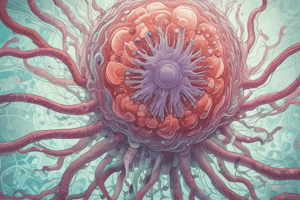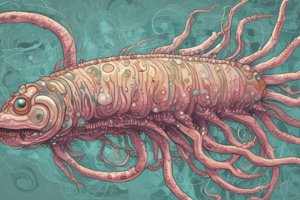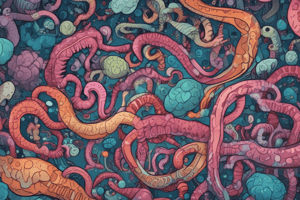Podcast
Questions and Answers
What distinguishes MOLLICUTES from bacteria?
What distinguishes MOLLICUTES from bacteria?
- Ability to grow on artificial media
- Gram-positive staining
- Absence of true cell wall (correct)
- Presence of cross walls
How are phytoplasmas distinguished in terms of cell wall structure?
How are phytoplasmas distinguished in terms of cell wall structure?
- Possess peptidoglycan cell walls
- Lack a true cell wall (correct)
- Contain cellulose cell walls
- Have gram-positive cell walls
Which statement is true regarding the reproduction of phytoplasmas?
Which statement is true regarding the reproduction of phytoplasmas?
- Reproduce by forming spores
- Have flagella for motility
- Multiply through binary transverse fission (correct)
- Require artificial media for growth
What is a distinguishing feature of spiroplasmas regarding shape?
What is a distinguishing feature of spiroplasmas regarding shape?
How do spiroplasmas move within their environment?
How do spiroplasmas move within their environment?
Why are phytoplasmas unable to be grown on artificial media?
Why are phytoplasmas unable to be grown on artificial media?
Where are phytoplasma and spiroplasma present?
Where are phytoplasma and spiroplasma present?
How are phytoplasma and spiroplasma transmitted from plant to plant?
How are phytoplasma and spiroplasma transmitted from plant to plant?
What is required for the vector to transmit mollicutes after feeding on infected plants?
What is required for the vector to transmit mollicutes after feeding on infected plants?
Where does the mollicute multiply first within the insect vector if acquired from the plant?
Where does the mollicute multiply first within the insect vector if acquired from the plant?
When do more insects become vectors for mollicutes?
When do more insects become vectors for mollicutes?
What body parts of the insect vectors can phytoplasma and spiroplasma grow in?
What body parts of the insect vectors can phytoplasma and spiroplasma grow in?




